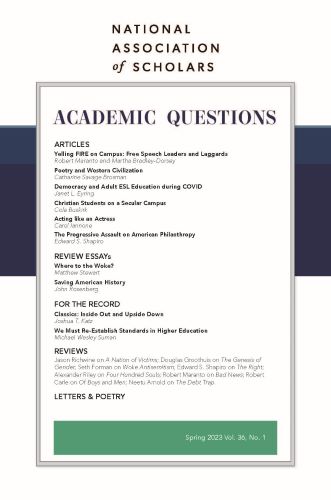Of Boys and Men, Richard V. Reeves, Brookings Institute Press, 2022, pp. 252, $24.99 hardcover.
Robert Carle is a professor of theology at The King’s College in Manhattan; [email protected]. Dr. Carle has contributed to Wall Street Journal, The American Interest, Newsday, Society, Human Rights Review, The Public Discourse, Academic Questions, and Reason. He last appeared in AQ with “The Elusive Robert E. Lee,” a review of Allen Guelzo’s Robert E. Lee: A Life.
Irina Dunn’s 1970 declaration that “a woman needs a man like a fish needs a bicycle,” was a rallying cry for twentieth century feminists. The satirical nineteenth century poem, “What is a Bachelor,” might be a rallying cry for twenty-first century men. A bachelor is “a pump without a handle . . . a horse without a saddle . . . a boat without a paddle . . . a two-legged stool.” (38)
Women are now the main breadwinners in 41 percent of American households. Most mothers now work full-time, and in half of families where both parents work full-time, mothers earn more than fathers. Among men with only a high school diploma, one third have dropped out of the labor force. For men with a job, real wages have declined by fourteen percent since 1979. Forty percent of births in the United States now take place outside marriage, up from eleven percent in 1970.
Irina Dunn might celebrate these changes, but what do they mean for men? In his new book Of Boys and Men, Richard V. Reeves argues that they signal “the decreasing marginal utility of men.” (36) Economically independent women can now flourish whether they are married or single. “Wifeless men, by contrast, are often a mess,” Reeves writes. Compared to married men, their health is worse, their employment rates are lower, their social networks are weaker.
Men account for almost three out of four deaths of despair, either from suicide or overdose. “Useless” and “worthless” are the words men who attempt suicide used most often to describe themselves. Divorce is now twice as likely to be initiated by a woman than by a man, and it is harder on men than on women. For all their jokes about balls and chains, men seem to intuit this. In a 2016 poll, more men than women ranked being married as “very important” (58 v. 47 percent). Men don’t want to be two-legged stools.
Reeves is a senior fellow at the Brookings Institution, and he is father to three boys. He describes vividly a culture that leaves large numbers of its men and boys isolated, angry, alienated, and without useful work. Reeves criticizes both conservatives and liberals for creating this sorry situation, but he directs most of his ire against cultural elites (like his colleagues at the Brookings Institution) who have created systems and structures that define masculinity as pathology.
Toxic Masculinity
“My sons attended a school with a culture of ‘toxic masculinity,’” Richard Reeves writes. Reeves’s three sons graduated from Bethesda-Chevy Chase High School in an affluent, liberal suburb outside of Washington D.C. “If there is a liberal bubble, this is the bubble inside the bubble,” Reeves writes. (105)
In 2018, Bethesda-Chevy Chase High School was disgraced when a boy at the school shared with his friends a list of the females in his class that he considered to be attractive. Months later, a female classmate saw the list on a boy’s laptop and complained to the school administration. The school punished the boy with detention. CBS, NBC, ABC, and The Washington Post all covered this incident, framing it as “toxic masculinity.” “It is one thing to point out that there are aspects of masculinity that are immature and can be harmful, it is another to suggest that a naturally occurring trait in boys and men is intrinsically bad,” Reeves writes. (106) Adolescent girls routinely cyberbully, yet we don’t call this “toxic femininity.”
Slapping the label “toxic masculinity” onto behavior in boys we find objectionable is deeply alienating, Reeves writes. “Very few boys and men are likely to embrace the idea that there is something toxic in them that needs to be exorcized.” (106)
Reeves excoriates the American Psychiatric Association (APA) for pathologizing masculinity in this way. The 2018 APA guidelines state that “traditional masculinity—marked by stoicism, competitiveness, dominance and aggression—is, on the whole, harmful.” The guidelines go on to condemn a “masculine ideology” characterized by “achievement, eschewal of the appearance of weakness, and adventure, risk, and violence.”1 The guidelines contain not a single reference to positive aspects of masculinity. This guidance is fed to psychologists, the vast majority of whom are women, who diagnose one in five American boys as mentally or developmentally impaired.
Peggy Orenstein interviewed dozens of adolescent boys for her book Boys and Sex. When she asked boys what they liked about being a boy, her subjects drew a blank. One student responded, “I never really thought about that. You hear a lot more about what is wrong with guys.”2 Reeves writes, “To a boy or man who feels lusty or restless, the message [is] there is something wrong with you.” (107)
Reeves acknowledges that masculinity has downsides, but our cultural elites rarely celebrate its upsides. Men commit over 95 percent of homicides, and the overwhelming majority of violent acts of other kinds. But men are also much more likely to risk their lives to save a stranger. Each year, Carnegie Hero Fund, founded in 1904, issues medals to civilians for courageous acts. In 2021, sixty-six of the seventy-one medals were awarded to men. (92)
Our educators and our educational systems treat boys like defective girls, with tragic consequences. In teacher–student assessments in the early grades, the girl–boy gap in reading is more than 300 percent larger3 than the white–black reading gap. Today in the United States, for every one-hundred bachelor's degrees awarded to women, seventy-four are awarded to men. Male college students are at higher risk of dropping out of college than any other group, including poor students, black students, or foreign-born students.
Of Boys and Men ends with a series of policy proposals to address these challenges. Reeves wants boys to start school a year later than girls (a bit like “redshirting” in college sports). He wants more male teachers in the classroom. He wants better vocational education. All of these are admirable proposals that could make the classroom more hospitable for boys. A Canadian study of one million six- to twelve-year-olds confirms Reeves’s intuition about the benefits of redshirting.4 The study found that boys born in December, who start school one year earlier than January babies, were 41 percent more likely to be medicated for ADHD than boys born in January. Similar studies indicate beneficial effects of Reeves’s other proposals.5
Renewing our Civic Culture
Missing from Reeves’s book is an adequate treatment of how our impoverished civic culture affects boys and men. Reeves admits that he is a policy wonk who is more comfortable crunching numbers than grappling with cultural trends. Unfortunately, the isolation, mistrust, and alienation afflicting men cannot be addressed simply with policy tweaks. To restore confidence, belonging, and legitimacy, we need cultural and institutional renewal. Here, Reeves could be informed by the work of Yuval Levin, Tim Carney, Charles Murray, and Robert Putnam.
Several times, Reeves dismisses efforts to look back into American history for lessons that can instruct us. “We cannot turn the clock back,” he writes. This prevents him from drawing lessons from periods of civic renewal in American life when Americans did an exemplary job of socializing boys. At the beginning of the twentieth century, for example, Americans enjoyed an unprecedented era of peace, social order, civility, optimism, and achievement. Rates of crime, casual violence, and antisocial behavior plummeted. Pre-marital pregnancy rates dropped sharply, and alcohol consumption declined two-thirds from the previous era. Church attendance rose dramatically. Homes, farms, and streets became cleaner and more orderly.6
The successful socialization of boys into men was a precondition for this cultural renewal. At the turn of the last century, Americans developed a myriad of institutions in which boys would be tutored into manhood. Academies, summer camps, colleges, and apprenticeships in commerce and in the trades served some of these purposes, as did debating clubs, literary societies, and young men’s associations. Robert Putnam writes, “In an extraordinary birth of creativity between 1901 and 1910, most of the nationwide youth organizations that were to dominate the twentieth century were founded–the Boys Scouts, the Girl Scouts, Campfire Girls, 4-H, Boys and Girls Clubs, Big Brothers and Big Sisters.”7 In the same era, Americans founded the Red Cross, the NAACP, the Knights of Columbus, Hadassah, Rotary, PTA, the Sierra Club, the League of Women Voters, the American Bar Association.8 Through these organizations, America became a nation of joiners. Today, we are a nation of loners. A nation of loners is a precarious place for fatherless boys and single men.
But more than any institution, Americans credited fathers with having the most important civilizing effect on boys. In the Victorian mind, boys were thought to be the opposite of men. They were “outlaws,” “torments,” “primitive savages,” “brutish,” “Goths and Vandals.”9 Fathers had the primary responsibility of preparing sons for adulthood. The father was responsible for family religious devotions and for transmitting the values necessary to succeed in the workplace—perseverance, thrift, diligence, punctuality, industry, ambition. A father was expected to prepare his son for the world of work—and to use what influence he had to get his son started on his career.10
Reeves attacks the progressive idea that fathers have no distinct role to play in their sons’ development. “Fathers matter for their children’s welfare in ways that are different from, but equal to, those of mothers.” (172) Reeves calls for a “new” model of engaged fatherhood to replace the “old model of fatherhood based narrowly on economic provision.” (167) The model of fatherhood that Reeves presents (“dads teach, moms tend”) could have been torn, word for word, from a Victorian parenting manual. Unfortunately, Reeves explicitly rejects proposals to culturally and legally renew the one institution, marriage, that can permanently tie fathers to their sons. Such proposals might “turn the clock back.”
Reeves repeatedly compliments himself for his courage in writing Of Boys and Men. This is a revealing commentary on the impoverished state of our national discourse. Simply citing controversial data as a basis for serious discussion is a provocative act of betrayal in our polarized environment. As a culture, there are very few venues left where social problems can be openly and honestly debated. We should all applaud Of Boys and Men for confronting an urgent national problem, but the book’s policy proposals are too timid to address the wrenching dislocations afflicting our boys and men.
1 American Psychological Association, Boys and Men Guidelines Group, APA Guidelines for Psychological Practice with Boys and Men (2018), https://www.apa.org/about/policy/boys-men-practice-guidelines.pdf.
2 Peggy Orenstein, “The Miseducation of American Boys,” The Atlantic, January 2020.
3 Christopher Cornwall, David B. Mustard, Jessica Van Parys, “Noncognitive skills and the gender disparities in test scores and teacher assessments: Evidence from primary school,” IZA Discussion Papers, No. 5973, Institute for the Study of Labor (IZA), Bonn, https://nbn-resolving.de/urn:nbn:de:101:1-201110102225.
4 Richard Morrow, et al., “Influence of relative age on diagnosis and treatment of attention-deficit/hyperactivity disorder in children,” Canadian Medical Association Journal, April 17, 2012. https://www.ncbi.nlm.nih.gov/pmc/articles/PMC3328520/.
5 Kevin McGrath, Mark Sinclair, “More male primary-school teachers? Social benefits for boys and girls,” Gender and Education, 25:5 (2013): 531-547, DOI: 10.1080/09540253.2013.796342; Shaun Dougherty, Stephen Ross, “For male students, technical education in high school boosts earnings after graduation,” The Conversation, September 30, 2019.
6 James Lincoln Collier The Rise of Selfishness in America (New York: Oxford University Press, 1991), 18.
7 Robert Putnam, The Upswing (New York: Simon and Schuster, 2020), 116.
8 Ibid., 113.
9 Mrs. Manners, “Bad Habits Peculiar to Boys,” At Home and Abroad; or How to Behave (New York, 1853), 40-41. see also Henry David Thoreau, Walden, ed. Sherman Paul (Boston, 1960), 70.













